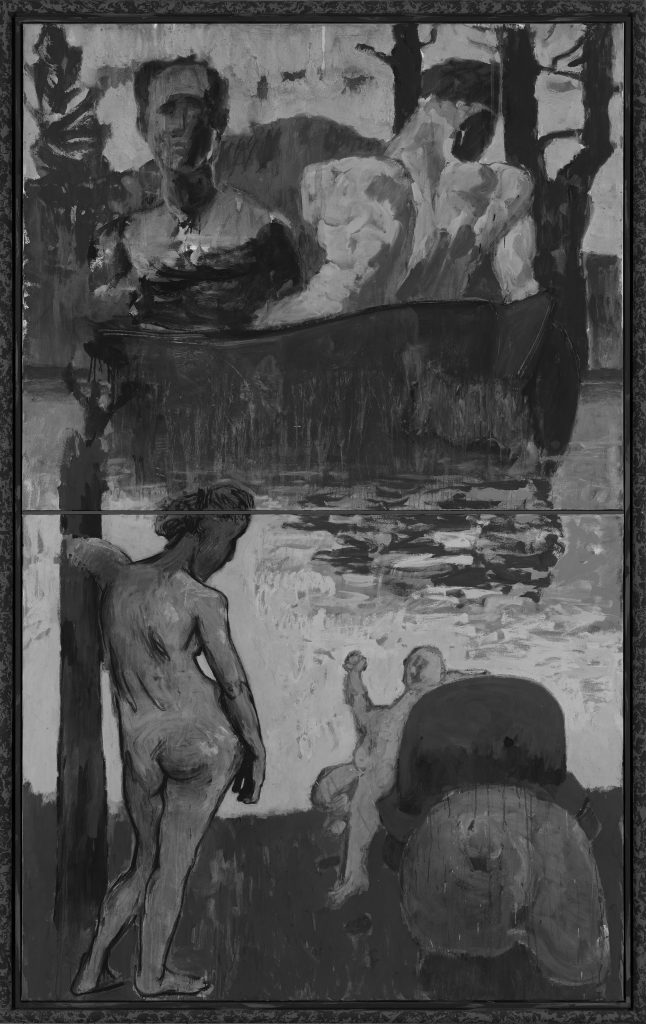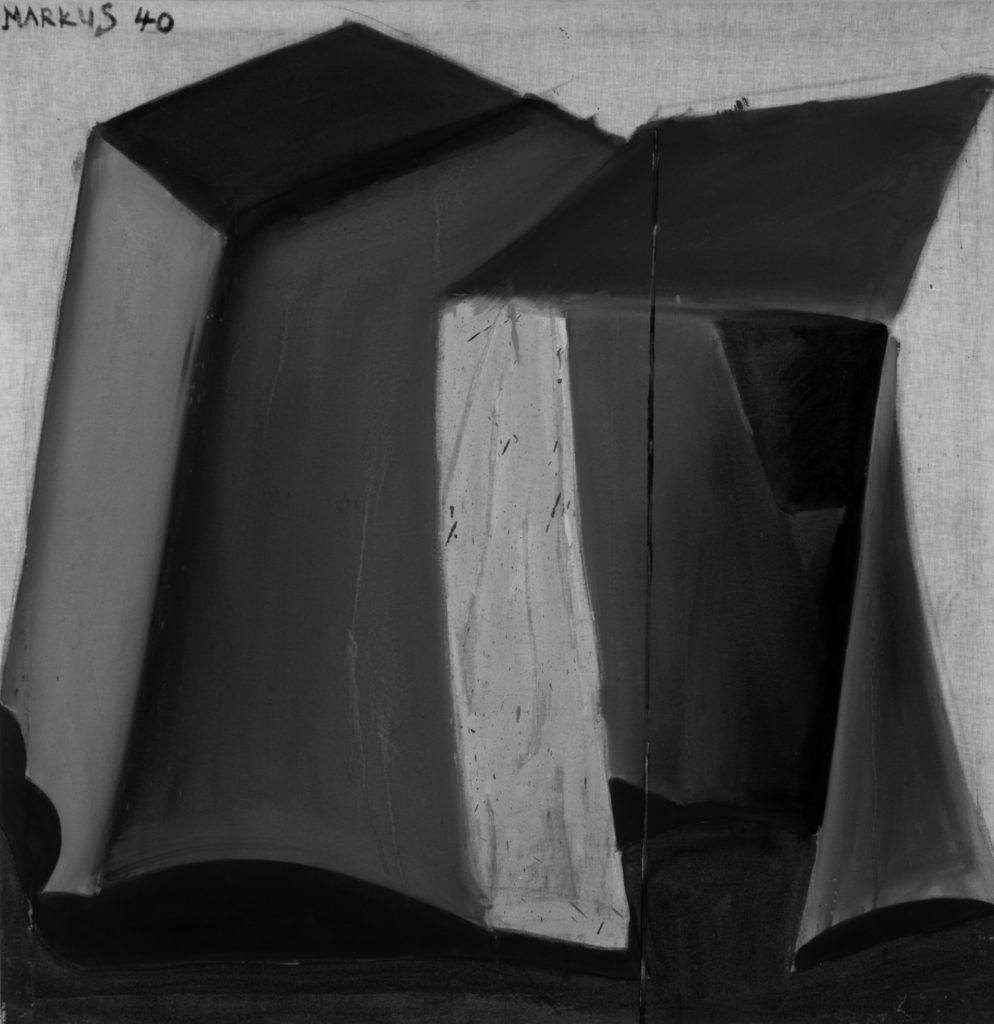Markus Lüpertz:
A Retrospective
Markus Lüpertz: A Retrospective
Musée d‘Art Moderne de la Ville de Paris
17.04.15 – 19.07.15
When one thinks of the great tradition of German painters, the works of Gerard Richter, Georg Baselitz or Martin Kippenberger promptly come to mind. Less mentioned, yet equally grand is the production of Markus Lüpertz, who has been active in the fields of painting, sculpture, poetry, editing, education and piano playing for over fifty years. The first two aspects of his prolific practice were recently the subject of a major retrospective at the Musée d’Art Moderne de la Ville de Paris.
The exhibition started with Arcadias, an ongoing series of paintings initiated in 2013. This unusual decision by curator Julia Garimorth empowered the show with great freshness, enabling the viewer to take the artist’s most recent production as a reference point. The Arcadias are large-scale canvases – as becomes clear in the next few rooms, the artist has a taste for immersive formats – depicting open-air landscapes inhabited by human figures. The grace of their pose and the absence of their limbs suggest a link with Greek and Roman sculptures as we now know them, whereas the paintings’ motifs further allude to the rich mythology which inspired art-making in antiquity. Arcadia is a utopian place which epitomises the ideal of living in harmony with nature – a somehow precursor of the myth of the noble savage. Lüpertz’s Arcadias evoke mythological scenes by juxtaposing this bucolic ideal with darker elements such as helmets and body armour, introducing the viewer to his dense half-figurative, half-abstract style and – as it also becomes evident in the rest of the show – his persistent interest in ancient mythology.
Markus Lüpertz’s practice is grouped under thematic umbrellas, each of which contains a similar set of motifs that the artist was interested in the time he created them. In the subsequent rooms, the viewer is presented with a selection of sculptures and paintings conceived with various materials, from tempera to gouache and oil, stone to bronze. In series like Men Without women. Parsifal ( 1993 – 1997 ) and The Mycenaean Smile ( 1985 ), the artist continues to express his interest in art history and mythology, whereas War ( 1992 ) brings the subject of violence – which permeates most of his production – to the forefront. This group is formed by four paintings titled Massacre, Dictatorship, Theatre of the Front and Heroic Death, shamelessly alluding to the darkest periods of history. Like most of the works, whether historic or contemporary, that depict moments of war, the topicality of their subject matter is uncanny. Lüpertz is often is noted as being among the first artists in the postwar period to expose the horrors of the recent history of his native Germany. Notably, his personal trajectory can hardly be dissociated from that of his country, as he was born in 1941 in Reichenberg ( now Liberec, Czech Republic ), then occupied by the Nazis. It is ironic that the ideal of beauty endorsed by the Nazis, influential in the works of ‘official’ artists from the regime such as Josef Thorak or Arno Breker, happens to reference the same ancient aesthetics that is so dear to Lüpertz.
If horrors are portrayed as images in the graphic compositions of War and German Motifs ( 1970 – 1976 ), the artist finds a way of evoking them even in his most abstract works. Such is the case of Congo ( 1981 – 1982 ), a rather geometric series of paintings prompted by an invitation to partake in an exhibition at Brussels’ Palais des Beaux-Arts in 1981. Curiously, it was during this less-figurative period that the artist took on sculpting. His three-dimensional works seems to be born from his canvases, addressing mostly the human body – or fragments of it – in a non-human scale and deformed way; they are often heavily painted in shiny, non-realistic colours.
After Poussin ( 1989 – 1990 ) offers some relief from his denser works. Here Lüpertz alludes to a different kind of mythology, borrowing elements from well-known paintings to create outlandish compositions. Joining Poussin,this affective plagiarism includes references to Goya, Courbet and Picasso, fragments of whose work are either collaged or added in a quite different palette of colours then the one the artist generally uses, as if to highlight the appropriation process. The poor lighting of this room did not diminish the greatness of its content, and its interesting to imagine Lüpertz assembling these quasi-figurative canvases, putting himself in other artists’ shoes while reinterpreting their masterpieces in his own style. At this point, the narrative of the show was interrupted by the presentation of a documentary film, greeting the viewer with a glimpse of Lüpertz’s flamboyant persona and eccentric artistic process.

Markus Lüpertz, Untitled, 2013. Michael Werner Gallery, Märkisch Wilmersdorf, New York and London. 马库斯•吕佩尔茨《无题》2013. 马塞尔•沃那画廊,Märkisch Wilmersdorf,纽约,伦敦。
The exhibition ends with a single work from his earliest series, Donald Duck ( 1963 ), where we see an abstract interpretation of the popular character in vibrant colours. At the time he painted it, Lüpertz was 22 years old, rehearsing ways in which to shape his artistic style in opposition to Abstract Expressionist and Pop trends – hence the appropriation of the duck – that were fashionable in the 1960s. It was probably not long until he found what was to become his signature style, since his early Dithyrambic Painting series were conceived in that same year. It felt slightly random to end an exhibition with over 140 pieces from various periods with a single work from a given series, but it was somehow another brave move by the curators to finish the narrative at the actual beginning rather than the notorious one. Never boring, the retrospective includes high and low moments from the artist’s career with equal honesty. The visitor is left to construct a personal narrative of the show, perhaps attempting to regroup the works in a cause and effect system, where an interest or motif is directly linked to a subsequent one. What could have been a disastrous anti-climax proved itself to be a delightful approach to how to tell a story. And the artist’s trajectory continues.
马库斯·吕佩尔茨回顾展
巴黎市立现代艺术博物馆
2015年4月17日至7月19日
译者:贺潇
当人们一想到德国绘画的伟大传统,格哈特·里希特、乔治·巴塞利兹或者马丁·基彭伯格的作品就会跃然于脑海中。马库斯·吕佩尔茨的创作很少被提及,但却同样重要,五十年来他一直活跃在绘画、雕塑、诗歌、编辑和钢琴演奏领域。他丰富多产的实践中的绘画和雕塑,最近成为在巴黎市立现代艺术博物馆一次大型回顾展的主题。
展览从《阿卡迪亚》开始,这是2013年开始而仍在进行中的绘画系列。策展人茱莉亚·加利莫尔茨这个非同寻常的决定给这个展览赋予了极大的新鲜感,使得观众能够把艺术家最新的创作作为参照点。《阿卡迪亚》是大型布面油画——在接下来几间展厅里非常明显,艺术家对身临其境的风格情有独钟——刻画了人类居住的户外风景。姿势的优雅和腿臂的缺失暗示了作品和我们所熟识的希腊、罗马雕塑之间的联系,而绘画的主题又进一步暗示了给古代艺术创作赋予了丰富灵感的神话故事。阿卡迪亚是一个乌托邦之地,象征了与自然和谐相处的理想——某种程度上是《高贵野蛮人》神话的先驱。吕佩尔茨的《阿卡迪亚》把这种田园式的理想与头盔和铠甲等等的黑暗元素并置在一起令人联想到了神话故事的意境,将观众引入了他那稠密的半具象、半抽象的风格中以及——在展览其他部分中也十分明显的——他对古代神话一贯的兴趣。
马库斯·吕佩尔茨的作品被归纳到多个不同的主题之下,每个都包含了艺术家在创作时感兴趣的类似意象。在接下来的展厅中,观众面对的是用不同材料构思出来的雕塑和绘画,从蛋彩画到水粉画和油画,从岩石到青铜。在《没有女人的男人。帕西法尔》( 1993 – 1997 )和《迈锡尼的微笑》( 1985 )等系列中,艺术家继续表达着自己对艺术史和神话的兴趣,而《战争》( 1992 )则把暴力——这个弥漫在他大部分创作中的主题——放置在显著的位置。这一组是由四幅油画组成的,分别题为《大屠杀》、《专制》、《前方的剧院》和《英勇牺牲》,毫无顾虑地暗示了历史上最黑暗的时期。就像大部分刻画战争瞬间的艺术作品一样——不论是历史上还是当代的——这些主题的现实性是难以置信的。吕佩尔茨也往往被认为是战后最早揭露其祖国德国的近代史中令人惊骇之处的艺术家之一。值得注意的是,他的个人轨迹也几乎无法同他的祖国脱离关系,他于1941年在赖兴贝格( 今天捷克共和国的利贝雷茨 )出生,随后被纳粹占领。具有讽刺意味的是,纳粹所认可的审美标准,于这一时期的‘官方’画家,诸如约瑟夫·托拉克或阿诺·布雷克的作品中富有很大的影响力,而这恰恰又是吕佩尔茨所青睐的古代审美。

马库斯•吕佩尔茨《帐篷 40——狂热主义》1965。马塞尔•沃那画廊,Märkisch Wilmersdorf,纽约,伦敦。Markus Lüpertz, Zelt 40 – dithyrambisch, 1965. Michael Werner Gallery, Märkisch Wilmersdorf, New York and London.
如果说在《战争》和《德国意象》( 1970 – 1976 )中恐怖被当作影像般以图像构成刻画出来的话,那么艺术家找到了一种,甚至在他最抽象的作品中也能唤起了这种感觉的方法。例如《刚果》( 1981 – 1982 ),艺术家因1981年偶然应邀参加布鲁塞尔美术宫的一次展览而开始创作的几何图形油画系列。令人好奇的是,恰恰是这段非具象的时期,艺术家开始从事雕塑创作。他的三维作品似乎源自于他的画布,表现的大多是人类的躯体——或其片段——以非人类的比例和畸形的方式呈现,并往往以明亮而不现实的色彩涂得非常厚重。
《效仿普桑》( 1989 – 1990 )提供了某种避开他更厚重的作品的避难所。吕佩尔茨在这里暗示了一种不同的神话,从著名画作中借用了元素,营造了奇异的画面。除了对普桑之外,这种情感表达的剽窃之物还包括戈雅、库尔贝和毕加索,他们的作品片段通过以他们不常用的色彩系列,仿佛可以强调挪用的过程般的被拼贴或添加进来。展厅昏暗的照明并没有削弱其内容的强烈,吕佩尔茨把这些半具象的画作组合在一起,让自己拜倒在其他艺术家的脚下,同时又以自己的风格重新阐释了他们的传世佳作,想象一下这一点都是非常有趣的。在此一刻,展览的叙事因为一部纪录片的播映而被打断了,让观众一睹吕佩尔茨夸张的个性和乖僻的艺术创作过程。
展览继续到博物馆光猛的曲线形展厅中,在这里悬挂着他历久不衰的《酒神之歌》系列( 1963 – 1976 )。观众终欣赏到他突破性的作品,而被他那种特有的——即便有些不拘一格的——风格所折服,更经历了这广泛地迷住了60年代大众的美学。作为记忆过程本身,正当我们走向其起点的时候,这些元素开始从艺术家的语汇中消失,这些最潜在的变化就在于三维性从空间中缺失。然而还有另一些重要的场景,由大幅的画布组成,勇士和艺术家的工具一次就用简洁的色彩描绘了出来,占据了大部分的画面。我们辨别出了头盔——到目前为止已经是老相识了——以及营帐、电线杆和调色板,这些元素又重新出现在每一幅画面中。这些形状非但以简约的、近乎抽象的方式再现出来,以暗示取代明确,而作为艺术家后期作品中核心的人类肢体刚完全消失。‘酒神之歌’这个词指的是古代希腊庆祝酒神的狂热音乐舞蹈仪式,而酒神则是希腊诸神中最异端的一位。历史上这一祭仪给了很多艺术家和作家以灵感,其中就有吕佩尔茨的德国同胞弗雷德里希·尼采,在《悲剧的诞生》( 1892 )中,便以此对比阿波罗纪律严明的追随者们所实施的祭仪。于是,古代神话首先以系列标题的形式进入了吕佩尔茨的语汇,经年累月,一直到发展成为一种审美形式。
展览用最早的《唐老鸭》系列( 1963 )中的一幅作为结尾,我们看到以缤纷色彩对这一个大众形象的抽象阐释。画这幅作品时,吕佩尔茨只有22岁,预演着他那艺术手法,以对抗抽象表现主义和波普趋势——于是挪用了唐老鸭——在1960年代极为流行。他很快就找到了自己的标志性风格,因为早期的《酒神之歌》系列就是差不多于同年构思出来的。以单幅作品来为一个展出140幅来自不同时期系列的作品展览结尾似乎有些随意,但以实际的开端,而非众所周知的那一幕作为叙事的终结的策展角度,在某种程度上是勇敢的。回顾展永远不会令人生厌,以同样的真挚把艺术家创作生涯中的各个瞬间都纳入进来。观众可以构建个人对这个展览的叙事,也许试图按照因果关系去重组这些作品,而趣味或主题直接与下面即将发生的有所关连。一种虎头蛇尾的态度恰恰证明自己是一种令人愉悦的讲故事的手法。而艺术家自己的轨迹仍然延续。